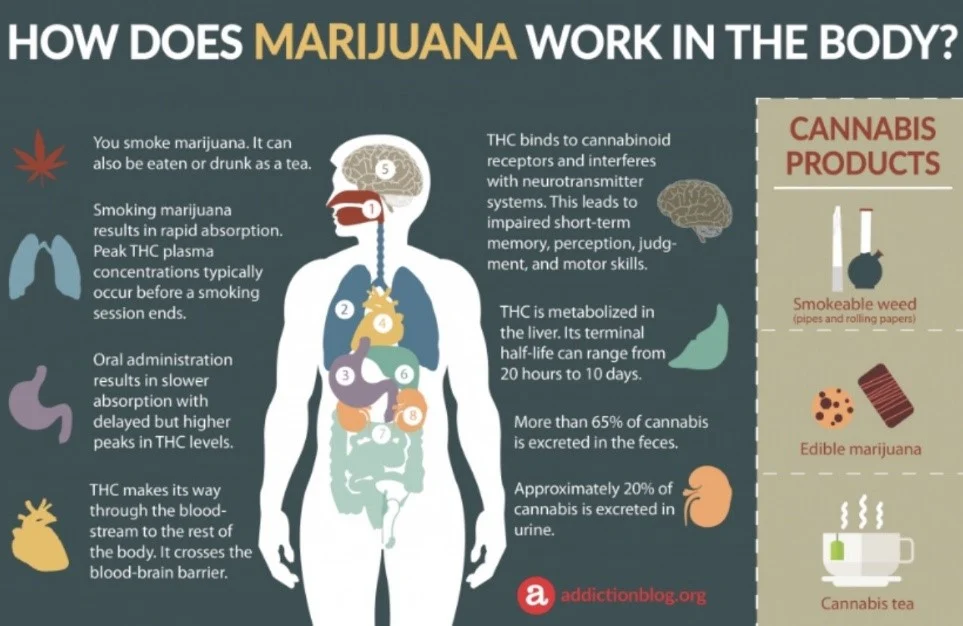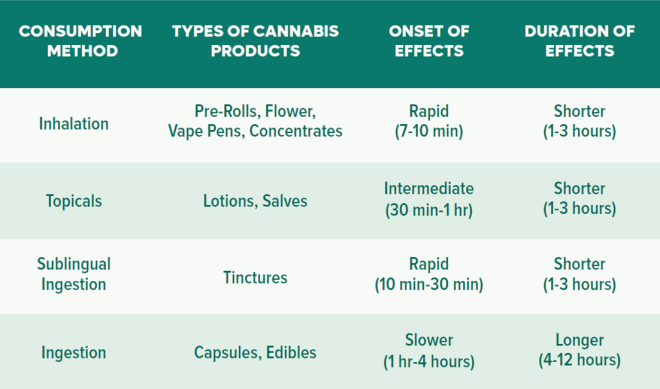How long does weed stay in the system after quitting? It varies by usage frequency, metabolism, and body composition. Generally, THC can be detectable for days to weeks. This article outlines key factors and drug test timelines related to how long does weed stay in the system after quitting.
Key Takeaways
- THC can remain in the body for varying durations based on frequency of use, metabolic rate, and body composition, with occasional users clearing THC in about 10 days and heavy users retaining it for up to 30 days or more.
- Different modes of cannabis consumption impact how long THC stays detectable in the system, with smoking resulting in shorter detection periods compared to edibles, which have longer retention times.
- Hydration and a balanced diet are essential for detoxification, aiding liver function to metabolize THC effectively, while exercise can also enhance the elimination of THC from the body.
Understanding THC Metabolism

Upon inhalation of marijuana, THC is rapidly absorbed into the bloodstream and then spreads to be stored in organs and fatty tissues. From there, it undergoes metabolism by the liver before being eliminated via urine and feces. The speed of this process varies based on individual metabolic rates and general health conditions.
THC has an affinity for binding with fat cells, which leads to its extended presence within those who have a higher amount of body fat. As these individuals metabolize THC, it may re-enter the bloodstream from the fatty tissues prompting additional metabolism, thus prolonging its potential detection time following initial use.
The role played by the liver in breaking down THC into various byproducts that are ultimately expelled from the body cannot be overstated. Factors such as age, overall wellness, and rate of metabolism markedly impact how quickly THC is processed out of one’s system. Understanding these factors can assist in predicting how long traces of THC might persist after consumption.
Frequency of Marijuana Use
The frequency of cannabis consumption has a direct impact on the duration THC metabolites are detectable in your body. For infrequent users, THC may be traceable for around 10 days post-use. For those who use marijuana regularly or heavily, traces of THC can linger and be detected several weeks after their last use.
Consuming large amounts of potent strains can increase the length of time weed stays in your system over a significant period. Habitual consumers or individuals using high-strength cannabis products might test positive for THC up to 30 days or longer. The detectability window varies depending on factors like quantity consumed and how long weed remains discernible in the system, as well as its effects on the human body and how long does weed stay present.
Understanding these variables is vital when preparing for potential drug tests and regulating your use of marijuana with consideration to upcoming drug screens.
Body Composition and Metabolism
Body composition, especially body fat percentage, significantly influences THC retention. THC metabolites are stored in fatty tissues and fat molecules, so individuals with higher body fat percentages may retain them longer, while those with lower body fat percentages tend to eliminate THC faster.
Metabolic rate also plays a crucial role. Individuals with faster metabolisms process and eliminate THC more rapidly than those with slower metabolisms. Personal factors such as frequency of use, body mass index, and overall health greatly influence how long THC stays in the system.
Hydration and Diet Impact
Drinking a substantial amount of water can assist in eliminating THC metabolites from the body by enhancing urine production, which can help expedite the removal of THC. Although this practice does not ensure a negative drug test result, maintaining adequate hydration levels is beneficial for aiding in detoxification.
Consuming a diet full of nutrients aids in optimal liver performance, which is crucial for breaking down and getting rid of THC. While there are detox supplements that might support metabolic processes, prioritizing a nutritious diet along with sufficient fluid intake should be considered the main strategy for detoxifying the body.
Modes of Cannabis Consumption

The way you consume cannabis has a significant impact on the duration that THC metabolites remain in your body. When you smoke or vape, THC quickly enters your bloodstream, prompting immediate effects but also leading to a more rapid metabolism of the substance by your body and thus a shorter time frame for detecting THC.
Alternatively, consuming cannabis through edibles extends the period during which it is possible to detect THC metabolites. This is because edibles are processed via the digestive system—a slower mechanism—which means that THCs stay in your system longer.
Understanding these variances allows for an estimation of detection periods depending on how you have consumed cannabis.
Urine Drug Tests
Urine tests are widely utilized to identify marijuana presence because they are efficient and offer a broad detection timeframe. THC, the active compound in marijuana, may be found in an occasional user’s urine up to two weeks after use. Those who use it regularly can continue to show positive results on a urine test for THC for 30 days or even longer.
In cases of heavy usage, individuals might still receive a positive result from drug tests as much as 90 days following their last consumption of marijuana. Although increasing fluid intake can reduce the concentration of THC metabolites in the urine, it is not guaranteed to ensure passing a drug test successfully. Understanding these varying windows of detection is crucial when preparing for impending drug screenings.
Hair Follicle Drug Tests
Hair follicle tests are capable of uncovering evidence of marijuana use for a period extending to three months post-consumption. This is because THC metabolites become embedded within the hair follicles, providing a historical record of drug use as the hair lengthens.
When conducting a typical hair test, the most recent 1.5 inches of growth closest to the scalp is examined, which corresponds with an individual’s drug history over the previous 90 days. These types of tests might not always catch occasional or sparse usage of marijuana—studies have shown that 39% percent of light users may still result in positive outcomes during drug testing for THC presence.
Saliva Drug Tests
Drug tests utilizing saliva are effective in pinpointing the recent use of marijuana. Their non-invasive nature and swift outcome generation make them favored options for both employers and law enforcement agencies. THC, the active component of marijuana, is traceable in saliva up to 24 hours post-consumption and may reach up to 30 hours under certain circumstances.
When it comes to edibles, the detectability window extends with THC remaining identifiable in one’s saliva as long as 44 hours after ingestion. The substantial uptake of THC through oral tissues renders these saliva tests proficient at detecting fresh cannabis consumption, thereby offering an immediate measure of impairment.
Blood Drug Tests
THC blood tests are not as frequently utilized because they can only detect the substance for a brief period. Following consumption, THC levels in the blood usually remain identifiable for up to 12 hours, with maximum levels manifesting mere minutes after smoking and then dropping sharply.
Nevertheless, blood tests that screen for THC might be employed in certain scenarios such as medical examinations or legal situations due to their ability to quantify specific levels of THC. Detection periods may vary depending on how the cannabis was consumed and the quantity taken.
Exercise and Physical Activity
Engaging in consistent physical activity assists the body in metabolizing and expelling THC, as it accelerates metabolism and enhances the body’s ability to process and clear out THC. When exercising leads to sweating, this can aid in releasing THC that is stored within fat cells.
Maintaining an active lifestyle contributes positively to detoxification processes while fostering general health and wellness. Regular exercise encourages habits conducive to better managing cannabis consumption as well as boosting one’s physical condition.
Liver Function and Detoxification
The metabolism and detoxification of THC primarily occur in the liver, where it is transformed into different metabolites via the cytochrome P450 enzyme system. It is essential for the liver to function effectively to process and expel THC from the organism.
People with compromised liver capabilities might retain THC for an extended period because their impaired livers are less efficient at processing it. To improve detoxification, maintaining good liver health through a diet abundant in nutrients can be beneficial.
Potential for False Positives
Various elements can lead to erroneous outcomes in drug tests, with certain drugs such as efavirenz and proton pump inhibitors being associated with misleading indications of THC presence. Contrarily, NSAIDs and foods containing hemp are typically not responsible for producing false positives.
Employing more precise verification procedures like gas chromatography-mass spectrometry is advised to reduce the likelihood of misinterpreting test results. This approach enhances the distinction between actual positive readings and unwarranted alerts due to its superior accuracy.
Impact of Secondhand Marijuana Smoke
Exposure to secondhand marijuana smoke can result in detectable amounts of THC appearing in one’s blood and urine. It is not common for ordinary exposure levels to lead to a positive test outcome. The chances do increase when one experiences extended contact with the smoke in areas lacking proper ventilation. Yet, these situations are rare.
Studies have shown that it usually takes an excessive and sustained period of exposure to secondhand marijuana smoke for a drug test to return a positive result. Understanding this can reduce worries about accidental inhalation leading to testing issues.
Marijuana Use Disorder and Addiction Treatment

Continued use of marijuana over an extended period may result in addiction. Around 30% of those who frequently use marijuana develop some form of marijuana use disorder. Individuals who begin using it before the age of 18 are at a notably higher risk for developing an addiction later in life. The rise in potency and THC concentration found within cannabis products has been linked to this heightened likelihood, with weed consumption potentially intensifying such issues.
Effective interventions for treating marijuana addiction include behavioral therapies as well as cognitive-behavioral strategies. Another beneficial approach is motivational enhancement therapy. At South Shore Recovery Center, individuals engage closely with a healthcare team to tailor their recovery plans while ensuring that mental health considerations are incorporated into their substance abuse treatment programs.
The center offers family therapy sessions designed to bolster communication and provide support amongst families grappling with the effects of addiction-related challenges.
Professional Help and Detox Programs
For individuals grappling with marijuana addiction, it is essential to obtain professional assistance. The American Addiction Centers are dedicated to providing care based on scientific evidence for various intensities of substance abuse, including drugs and alcohol. They furnish a spectrum of services ranging from residential treatment options to outpatient programs complemented by onsite therapy sessions. These centers facilitate smooth progress from structured outpatient care into sustained recovery through meticulous aftercare strategies.
Securing expert aid equips those dealing with addiction with the vital tools and support necessary for conquering their dependencies and achieving lasting abstinence. While detox kits and herbal remedies might provide some relief, having a primary care provider ensures adherence to an organized approach that systematizes recovery efforts.
South Shore Recovery Center
The South Shore Recovery Center, located in Massachusetts, provides top-tier treatment options for those struggling with weed addiction. By combining personalized care plans and the administration of mental health services, they are a leading option for individuals pursuing recovery from cannabis dependence.
Summary
Understanding how long THC stays in your system requires knowledge of various factors, including metabolism, body composition, frequency of use, and methods of consumption. Drug tests such as urine, hair, saliva, and blood tests each have their own detection windows and limitations.
By staying informed and seeking professional help when needed, you can take control of your health and manage your cannabis use effectively. Whether you’re facing a drug test or looking to overcome marijuana addiction, the resources and information provided can guide you on your journey.
Frequently Asked Questions
How many days does it take for your weed tolerance to go away?
A cannabis tolerance break should last at least 21 days to effectively reduce tolerance, as it typically takes around three weeks for THC to leave your system.
Extending this break can further enhance its effectiveness.
Is 14 days enough to get weed out of the system?
Fourteen days is generally sufficient for most individuals to eliminate THC metabolites from their system, especially for infrequent users; however, time may vary based on factors such as body fat, metabolism, and frequency of use.
Thus, it is advisable to consider personal health factors when evaluating detox timelines.
Can drinking water help flush out THC faster?
Staying hydrated can help to eliminate THC metabolites from the body via urine, although it does not ensure that one will pass a drug test. The efficacy of this method differs from person to person.
Are hair follicle tests accurate for detecting marijuana use?
Hair follicle tests are indeed accurate for detecting marijuana use, as they can identify use for up to three months, making them reliable for long-term detection.
Can secondhand marijuana smoke cause a positive drug test?
Extended contact with secondhand marijuana smoke in spaces without proper ventilation may result in a positive outcome on a drug test, although usual levels of exposure are not expected to cause this effect.
To maintain the dependability of drug testing results, it is recommended to reduce one’s exposure to secondhand marijuana smoke.
